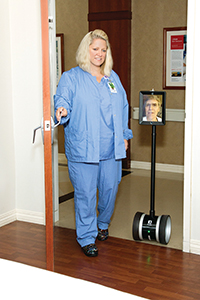Dr. Robert Lancey, a cardiothoracic surgeon at Bon Secours Maryview Medical Center in Portsmouth, Va., uses the robot to communicate with patients from his home at night. He sees and talks with them over the video-link on his smartphone.

Kristi Martel, a nurse in the Bon Secours Heart and Vascular Institute of Virginia at Bon Secours Maryview Medical Center in Portsmouth, Va., with a robot that doctors use for videoconferences with patients. On the screen is cardiothoracic surgeon Dr. Robert Lancey, who uses the device for nighttime checks on his patients
It's a supplement to, not a replacement for, traditional bedside rounds, Lancey said. And it usually gives him a better sense of a patient's comfort level and emotional state than does a standard night call to a nursing station, no matter how thorough the telephone report.
And the patients? Lancey said they like the extra communication, even over a medium that often is much more familiar to their grandchildren.
"A lot of our patients are over 70. They don't use social media. They don't have Facebook," Lancey said. "For many of them, it is rocket science. I thought there would be more negative reaction, but they see my face. We talk. They like it."
Bon Secours Virginia Health System has the robotic devices at three of its hospitals, including Maryview. They cost about $3,000 each, can be maneuvered remotely by smartphone and parked and kept in charging docks on the hospital floor, said Jeffrey Hartenberg, administrative director of the Heart and Vascular Institute for Bon Secours Hampton Roads, Va.
Hartenberg said many doctors resisted the idea when he first proposed it in March. Then he steered one into a staff meeting.
"They all wanted to take turns driving it," he said. "It certainly was an attention-getter."
Hartenberg said it takes about 15 minutes for an operator to learn how to drive it remotely. The machine is produced by Double Robotics of Sunnyvale, Calif. It balances upright upon two wheels like a Segway personal scooter. The video camera on the robot has wide-angle viewing, and the operator can raise or lower the telescoping mount to set the screen at a patient's eye level.
Lancey recommends becoming competent at the controls before using it to see a patient. "You don't want to crash it into a wall and have a patient think, 'This guy is going to cut into my chest?'" he said.
Lancey said the robot is no substitute for being bedside. He makes traditional hospital rounds two or three times each day. "Face to face contact is extremely important, not just for learning about my patient but for developing a trusting relationship," he said. "I don't use the robot in lieu of seeing my patients. But late at night, I think they realize that this is an extra session together that we wouldn't get otherwise. And it does give me another look."
Hartenberg said he believes the device has allowed some patients to go home sooner because the doctors can order changes in medication or care in the evening, rather than waiting for the next day. The device in use at Bon Secours Mary Immaculate Hospital in Newport News, Va., has allowed newly admitted patients to speak with the doctors at Maryview, 20 miles away, where more advanced heart operations are conducted.
"The reality is that we have competition for open-heart surgeries in our region," he said. In most cases, the first cardiac surgery hospital that a patient and family talk with, is where they opt to have the surgery. With the robot, "one of our doctors can have a first conversation with the family and say, 'I am a cardiothoracic surgeon. I'll be coming up shortly and make preparations to bring you to Maryview.'"
Hartenberg said plans are in the works for the Bon Secours Heart and Vascular Institute, which includes Maryview, to use the robots at more of its Virginia hospitals.
Copyright © 2014 by the Catholic Health Association
of the United States
For reprint permission, contact Betty Crosby or call (314) 253-3477.